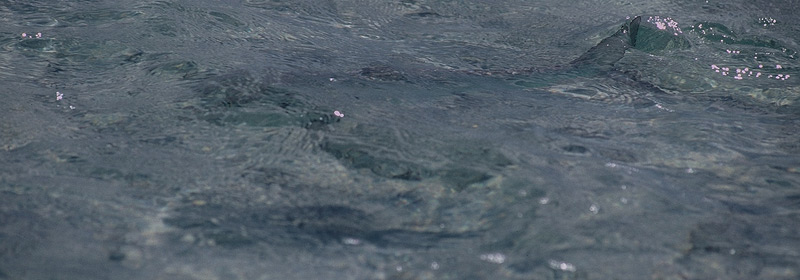
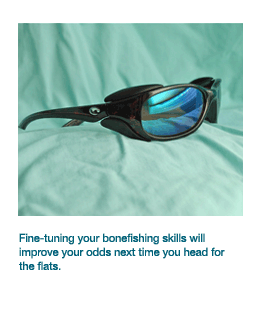

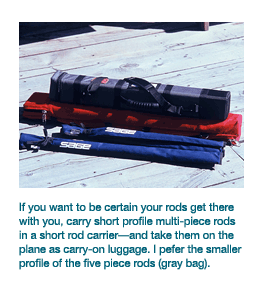

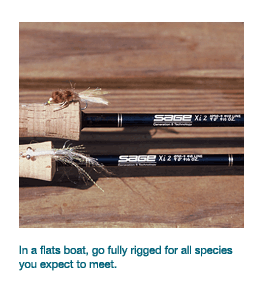
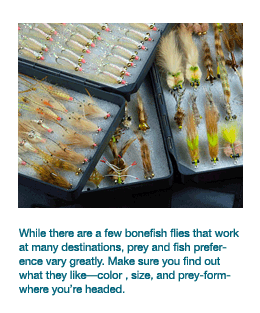
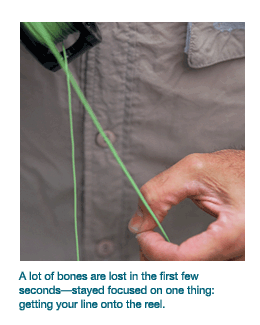
|
|
 From
time to time Dick posts tips here for improving your bonefish skills.
If you have a specific question you would like to ask, you can contact
him at 978 314 6879 or dick@dickbrownbonefishing.com. From
time to time Dick posts tips here for improving your bonefish skills.
If you have a specific question you would like to ask, you can contact
him at 978 314 6879 or dick@dickbrownbonefishing.com. 

See Fish Better
Locking onto the target is at the core of bonefishing—seeing its direction,
speed, and swimming demeanor tells you how and where to present your fly. Polaroid
glasses are essential to cut surface glare and side shields and a long brim
hat are critical to shutting out ambient sidelight. Together they can make
the difference between a day of hook-ups and a day of missed fish. I carry
two pair of polarized glasses, one with light amber lenses for low-light conditions
and one with dark amber lenses (shown) with a green anti-glare coating for
bright sun. Both have snap-in side-shields, which, combined with a good
bill-cap, block out most ambient side light—a must if you are really
serious about seeing fish.

The Best Knots and Rigging to Hook More
Bonefish with Fewer Break-offs
If you like using terminal knots that are tight to the fly, like
the clinch, try the Trilene, the Palomar, or the Orvis (Becker) knot—all
three are far stronger than the clinch. If you like your fly to move
more freely, use the no-slip loop—it’s easy to tie, fast,
and stronger than just about any other knot around.


Get There With Your Stuff
While some airlines will allow you to carry a 3-piece rod carrier on
board, which is about 42” long, many carriers will make you check
these long bags at the gate. I prefer 4-piece rods with a pack length
of 32” (red bag), which will get past most of the airline gate
screeners or 5-piece bags (gray bag), with a short 25” long profile,
which are even better.


Hooks: A Small Thing Can Make A Big Difference
A bonefish’s mouth is lined with ceramic-hard plates and may
resist penetration by dull or weak hooks. I‘ve also been surprised
by the violent hook-bending forces that even a medium sized bonefish
can generate as it realizes it is hooked and makes its first long-distance
run for open sea. The Gamakatsu SL11-3H has become one of my favorite
bonefish hooks, along with the Tiemco 811s, and the Daiichi 2546
for longer profiles.


If You Expect to Find Bones and Permit,
Go Fully Loaded for Both
If you are fishing where you might encounter permit as well as bonefish, you
should have two rods fully rigged and ready—one for each species. When
you spot a permit, there is no time to change a bonefish fly to a large crab
fly—you must be ready to cast immediately. I also usually rig for permit
with a 10wt floating line with a 10 ft. intermediate sink-tip instead of a full
floater to help get the fly to fish level and keep it there.


How to Stock Your Bonefish Fly Box
Prey varies at different destinations, so your destination should determine
the size, shape, and to some extent the color of your flies. Large profile
size 2 and 1 tan, olive, and gray flies are a must for the Florida Keys, sizes
2, 4 and 6 tan and beige flies with pink or orange highlights work well in
the Bahamas, Los Roques, and Christmas Island (with some brighter and flashier
additions in the Pacific). Belize fish eat smaller prey and sizes 6, 8 and
even 10 in blues greens, and oranges produce here. Seychelles fish want both
big-bodied flies like the Florida Keys and also some sparse patterns for spooky
cruisers and tailers. And wherever you go, you will need a range of differentially
weighted patterns (for example, lead and bead-chain eyes) and non-weighted
flies (hook-only weighted) for different water depths.


Priority One—Get the Fish onto
the Reel
You will lose fewer fish, if you concentrate on one thing when you
first hook-up—get the fish on the reel. Don’t take your
eyes away from your fly line—watch every coil as it comes up
off the deck and onto your reel and guide it with your line hand
to prevent snags, jams, and loop-overs that will break you off. Once
on the reel, you can watch the action and enjoy the thrill of the
run!
|
